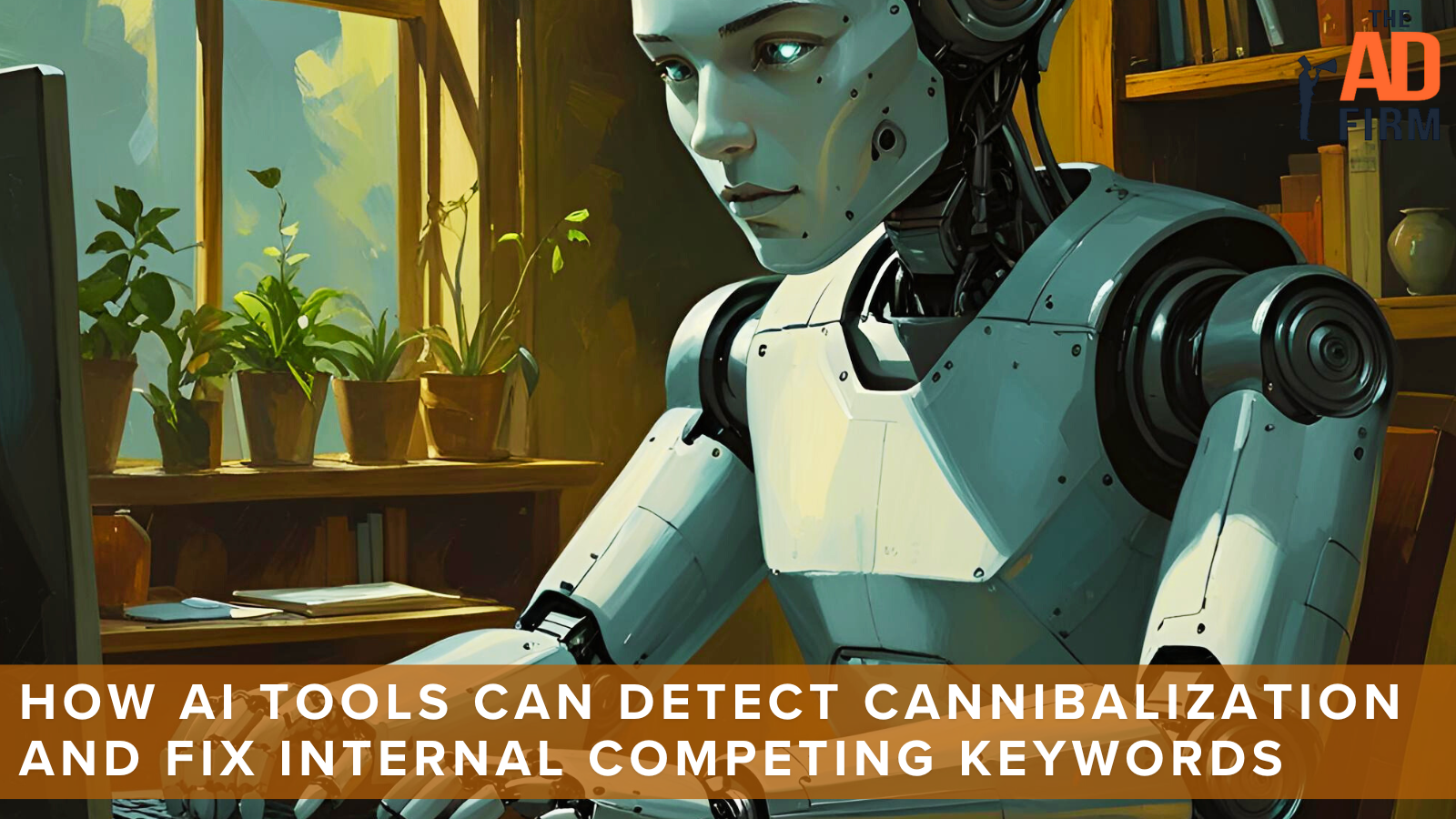If you’re still manually checking for keyword cannibalization, you might be missing critical issues while your competitors pull ahead. Smart SEO professionals, from enterprise teams to local SEO specialists, take a different approach: they use AI-powered detection that finds intent-based cannibalization in minutes, not days.
Manual analysis catches obvious keyword duplicates but completely misses semantic overlaps, intent conflicts, and subtle content competition that’s quietly destroying your rankings. The fundamental problem is that traditional methods look for exact keyword matches while missing the semantic relationships that actually drive search engine competition.
AI changes this completely. Instead of looking at just keywords, artificial intelligence analyzes semantic meaning, user intent, and content similarity using advanced natural language processing. This means catching cannibalization cases that traditional keyword-matching methods miss entirely.
What Is Keyword Cannibalization (And Why Manual Detection Fails)
Keyword cannibalization happens when multiple pages on your website target the same search intent, causing them to compete in search results. This internal competition splits your page authority, confuses Google about which page to rank, and ultimately hurts your visibility.
Most SEO professionals still use outdated manual methods to detect cannibalization. They’ll export Google Search Console data, create pivot tables, and manually review pages – a process that takes days and often misses subtle cases of intent overlap.
The fundamental problem: humans see words, AI understands meaning. Manual detection looks for exact keyword matches but misses the semantic relationships that actually drive search engine competition.
Why Traditional Detection Methods Miss Critical Issues
When a local SEO company manually checks for cannibalization, they typically search for exact keyword matches or use basic Google Search Console filters. This approach creates a false sense of security while critical problems remain hidden.
- Semantic Blindness: Manual analysis can’t detect when “best Italian restaurant” and “top Italian dining” target identical user intent with different keywords. You’ll mark these as safe while they compete directly in search results.
- Scale Impossibility: A typical business website has thousands of keyword-page combinations. Human analysis of 10,000+ potential conflicts is mathematically impossible to do accurately. You’ll check the obvious ones and miss the subtle cases that often cause the most damage.
- Intent Evolution Gap: Google’s understanding of search intent changes constantly during algorithm updates. Pages that weren’t competing last month might be cannibalizing now, but manual quarterly audits won’t catch this shift until months later.
- Time Decay Effect: By the time you manually identify all cannibalization issues through spreadsheet analysis, your rankings may have already suffered for weeks or months. Each day of delay compounds the damage.
The best local SEO services recognize these fundamental limitations and have moved beyond manual detection entirely.
Boost Your Business Growth with The Ad Firm
- PPC: Optimize your ad spends with our tailored PPC campaigns that promise higher conversions.
- Web Development: Develop a robust, scalable website optimized for user experience and conversions.
- Email Marketing: Engage your audience with personalized email marketing strategies designed for maximum impact.
How AI Detects Cannibalization Your Manual Audits Miss
AI excels at identifying cannibalization because it processes information in a manner similar to how search engines operate, through semantic understanding rather than superficial keyword matching. While you’re checking for exact keyword duplicates, AI is identifying the intent conflicts that actually matter to Google.
Text Embeddings: Mathematical Content Analysis
AI tools convert your page content into mathematical vectors called embeddings. Think of these as “content fingerprints” that capture the deeper meaning, context, and intent of your pages in numerical form.
The process works like this:
- AI analyzes your page titles, meta descriptions, headers, and content
- It creates numerical representations that mathematically encode semantic meaning
- It compares these representations using cosine similarity calculations
- Pages with high similarity scores (typically above 0.7-0.9) likely cannibalize each other
Real-World Example: A local SEO service provider discovered two pages they thought were distinct:
- Page A: “Emergency Plumber Services”
- Page B: “24/7 Plumbing Repairs”
Manual analysis marked these as targeting different keywords. AI detected a 0.94 similarity score – near-perfect cannibalization. Both pages targeted “urgent plumbing help” intent with different keyword approaches.
Intent-Based Detection Beyond Keywords
Traditional methods look for keyword overlaps. AI looks for intent overlaps. This fundamental shift identifies cases when pages answer the same user questions or solve the same problems, regardless of specific keyword usage.
AI might flag these pages as serving identical intent:
- “How to choose a contractor”
- “Contractor selection guide”
- “Finding the right contractor for your project”
- “What to look for in construction professionals”
Human analysis would miss this because the keywords differ significantly, but AI recognizes the identical user intent and flags the competition.
Real-Time Pattern Recognition
AI continuously analyzes your site’s performance patterns, identifying cannibalization through behavioral signals that humans can’t track manually:
- URL Flickering Detection: AI monitors when multiple URLs alternate in ranking for the same queries, indicating active cannibalization conflicts.
- Traffic Pattern Analysis: When traffic drops to one page after another goes live, AI identifies this as potential cannibalization faster than quarterly manual audits.
- Ranking Plateau Identification: AI recognizes when pages hit ranking plateaus despite optimization efforts, often indicating cannibalization holding them back.
Top AI Tools for Keyword Cannibalization Detection
Modern AI tools have revolutionized cannibalization detection, offering everything from free quick checks to enterprise-level predictive analysis. The key is choosing tools that match your technical expertise and website complexity, whether you need DIY solutions or comprehensive automated workflows.
Enhance Your Brand Visibility with The Ad Firm
- SEO: Enhance your online presence with our advanced SEO tactics designed for long-term success.
- Content Marketing: Tell your brand’s story through compelling content that engages and retains customers.
- Web Design: Design visually appealing and user-friendly websites that stand out in your industry.
OpenAI Text Embeddings
Best for: Technical users who want complete control and accuracy that often surpasses expensive enterprise solutions.
OpenAI’s text embedding models, particularly text-embedding-ada-002, can identify cannibalization with remarkable accuracy that often outperforms tools costing thousands per month. Testing across enterprise websites shows this DIY approach catches cannibalization cases that established SEO tools miss.
Unlike SEO tools that use simplified keyword matching, OpenAI embeddings analyze content the same way Google’s algorithms process semantic meaning. You’re essentially using the same mathematical approach that powers search engines.
- The Process: Extract page content, convert it to embeddings through OpenAI’s API, then calculate similarity scores using cosine similarity. Pages with similarity scores above 0.9 almost certainly cannibalize each other.
- Real Performance Data: A local SEO company using this method on a 5,000-page e-commerce site discovered 312 cannibalization clusters that Screaming Frog and SEMrush completely missed. The manual cost was under $50 in API usage versus $3,000+ for enterprise detection tools.
- Pros: Highly accurate, customizable analysis, cost-effective for large sites, uses the same technology as search engines
- Cons: Requires Python programming knowledge, initial setup complexity
Entail AI: Enterprise Cannibalization Intelligence
Best for: Agencies and enterprises managing multiple large websites who need predictive analysis and client reporting features.
Entail’s tool goes beyond detection to prediction, using advanced AI to map topical authority across your entire site and forecast locations where cannibalization might develop based on your content strategy.
While other tools find existing problems, Entail predicts future conflicts. Their topical authority graphs show relationships between pages and keywords, making it easy to spot content clusters that risk cannibalization before publishing.
- Visual Intelligence: The platform creates interactive topical authority maps showing how content clusters relate to each other. This visualization makes cannibalization patterns obvious to clients and team members who struggle with technical SEO concepts.
- Pros: Visual mapping, predictive analysis, client reporting features, enterprise scalability
- Cons: Higher cost ($200+ monthly), learning curve, focused on larger sites
SEO.ai Keyword Cannibalization Checker
Best for: Quick analysis of specific keyword sets without technical complexity.
Strengthen Your Online Authority with The Ad Firm
- SEO: Build a formidable online presence with SEO strategies designed for maximum impact.
- Web Design: Create a website that not only looks great but also performs well across all devices.
- Digital PR: Manage your online reputation and enhance visibility with strategic digital public relations.
This free tool uses AI to analyze SERP similarity and identify cannibalizing keywords. Simply input your keywords, and the AI analyzes Google search results to determine if they’re likely to compete.
Pros: Free access, fast results, no technical knowledge required
Cons: Limited to keyword analysis, doesn’t analyze full page content
Automated Workflow Solutions
Several digital marketing agency teams now use custom AI workflows built on platforms like AirOps. These workflows automatically:
- Crawl your site for content
- Generate embeddings for all pages
- Calculate similarity scores
- Identify cannibalization clusters
- Generate actionable reports
ALSO READ: 10 Best Local SEO Tools in 2025 to Boost Rankings & Save Time
Step-by-Step AI Cannibalization Detection Process
Successfully detecting cannibalization with AI requires a systematic approach that ensures accurate results and actionable insights. Following these four essential steps will help you identify competing content while avoiding false positives that waste time and resources.
Step 1: Content Extraction and Data Preparation
Start by extracting all your page URLs, titles, meta descriptions, and main content. For best results, focus on pages that actually target search traffic. This means prioritizing product pages, service pages, blog posts, landing pages, and informational content that targets specific search queries while excluding utility pages like contact forms, privacy policies, and terms of service that don’t compete for rankings.
Clean your data by removing navigation elements, footers, ads, and other non-content elements that don’t contribute to search engine evaluation. Focus on extracting the primary content that determines rankings: main body text, headings, image alt text, and embedded content that contributes to the page’s semantic meaning. The cleaner your data, the more accurate your AI analysis will be.
Step 2: Generate AI Embeddings
Convert your cleaned content into embeddings using your chosen AI tool. Most tools handle this automatically, but if you’re using OpenAI directly, you’ll process each page’s content through the embedding API.
Pay attention to embedding model choice. Testing shows text-embedding-ada-002 performs best for cannibalization detection, offering the right balance of accuracy and cost-effectiveness.
Maximize Your Online Impact with The Ad Firm
- Local SEO: Capture the local market with strategic SEO techniques that drive foot traffic and online sales.
- Digital PR: Boost your brand’s image with strategic digital PR that connects and resonates with your audience.
- PPC: Implement targeted PPC campaigns that effectively convert interest into action.
Step 3: Calculate Similarity Scores
Compare embeddings using cosine similarity calculations. This produces similarity scores between 0 and 1:
- 0.9+ indicates very likely cannibalization
- 0.7-0.9 suggests possible cannibalization requiring review
- Below 0.7 typically indicates distinct content
Step 4: Validate AI Findings
AI provides the analysis, but you make the decisions. Review flagged pages to confirm they actually serve the same user intent. Some pages might have high similarity scores but target different stages of the customer journey or different audience segments.
Consider these factors during validation:
- User intent and search behavior
- Business goals for each page
- Traffic and conversion performance
- Seasonal or temporal relevance
Fixing AI-Detected Cannibalization Issues
Once AI identifies your cannibalization issues, you need strategic fixes that preserve your SEO value while eliminating competition.
High Similarity Content (0.9+ Similarity Score)
Consolidation Strategy: Combine competing pages into one comprehensive resource. Choose the page with better performance metrics or domain authority, then redirect the other pages to it.
When consolidating:
- Preserve all valuable content across competing pages
- Maintain the best-performing URL structure
- Update internal links to point to the consolidated page
- Implement 301 redirects across old URLs
Medium Similarity Content (0.7-0.9 Similarity Score)
Differentiation Strategy: Modify pages to target distinct user intents or customer journey stages. This works when both pages have business value but overlap too much.
Differentiation tactics:
- Adjust content to target different search intents
- Focus on different customer journey stages
- Target different audience segments
- Optimize for different keyword variations with distinct intent
AI-Recommended Content Architecture
Smart local SEO service providers use AI insights to design better content architecture at the start. AI can predict which content topics might cannibalize before you create the pages.
Create content clusters around main topics, with clear intent differentiation between pages. Use AI to validate that new content won’t cannibalize existing pages before publication.
ALSO READ: No More Cannibalization: How to Keep City Pages Unique and SEO-Friendly
Advance Your Digital Reach with The Ad Firm
- Local SEO: Dominate your local market and attract more customers with targeted local SEO strategies.
- PPC: Use precise PPC management to draw high-quality traffic and boost your leads effectively.
- Content Marketing: Create and distribute valuable, relevant content that captivates your audience and builds authority.
Advanced AI Strategies for Cannibalization Prevention
As websites grow, the risk of keyword cannibalization increases. Advanced AI tools give marketers the ability to spot overlap, align content with user intent, and even predict conflicts before they happen. Instead of reacting after rankings drop, AI makes it possible to design a content strategy that works together rather than against itself.
Predictive Content Planning
Use AI to analyze your content roadmap and flag potential cannibalization before it happens. Upload planned topics and target keywords into your AI platform to compare them with existing assets.
This proactive process helps marketing teams:
- Prevent overlap between new and existing pages
- Protect rankings before they are diluted
- Save time by publishing content right the first time
Intent-Based Content Mapping
AI can organize your content library by search intent instead of just keywords. This gives a clearer picture of what user needs you are meeting and where you may be competing against yourself.
With intent mapping, you can:
- Identify funnel gaps where content is missing
- Spot areas of over-optimization for a single intent
- Create complementary content rather than duplicate coverage
- Balance content across every stage of the customer journey
Competitive Cannibalization Analysis
AI can also evaluate competitors. By scanning their content for cannibalization patterns, you gain insight into where they are weak and how to outpace them.
This approach allows you to:
- Detect competitor blind spots and missed opportunities
- Avoid repeating their structural mistakes
- Build a more efficient content hierarchy that strengthens rankings
Measuring Success After AI-Driven Fixes
Fixing cannibalization with AI is only valuable if you can prove the results. Tracking the right metrics will confirm whether your adjustments improved performance and stabilized your content strategy.
Ranking Improvements
Review whether pages that once competed against each other now rank more effectively on their own. Stronger individual rankings indicate that your AI-driven restructuring clarified search intent and improved topical authority.
Traffic Consolidation
Measure organic traffic to consolidated pages and compare it to the combined total of competing pages before the fix. A lift in traffic shows that Google now views the page as the definitive resource, which often leads to better long-term visibility.
Amplify Your Market Strategy with The Ad Firm
- PPC: Master the art of pay-per-click advertising to drive meaningful and measurable results.
- SEO: Elevate your visibility on search engines to attract more targeted traffic to your site.
- Content Marketing: Develop and implement a content marketing strategy that enhances brand recognition and customer engagement.
Reduced URL Flickering
Cannibalization often causes Google to alternate between two or more URLs for the same query. After your fixes, rankings should stabilize with one consistent URL appearing in results. This stability signals that search engines better understand your content hierarchy.
Improved Indexing
Use Google Search Console to confirm that issues like “crawled, not indexed” or “discovered, not indexed” have been resolved. Improved indexing means your site architecture is clearer and search engines can efficiently prioritize the right content.
Getting Started with AI Cannibalization Detection
Start small with free AI tools to understand how they identify cannibalization on your site. Use SEO.ai’s free checker or experiment with OpenAI embeddings on a small content sample.
Once you understand the insights AI provides, invest in more comprehensive tools or work with a local SEO company that uses advanced AI detection methods.
Remember, AI identifies the problems, but strategy fixes them. Combine AI’s analytical power with human understanding of user intent and business goals for the most effective cannibalization resolution.
Ready to stop losing rankings to your own content? The Ad Firm’s AI-powered cannibalization detection uncovers hidden issues destroying your search visibility. While your competitors waste weeks on manual audits, we identify and fix cannibalization conflicts in days, not months. Don’t let internal competition kill your SEO results. Contact The Ad Firm today for a free consultation and discover which pages are secretly competing against each other.






